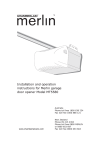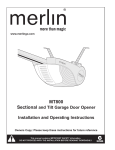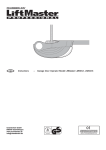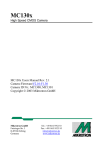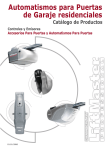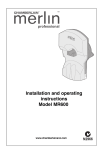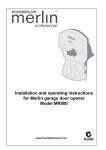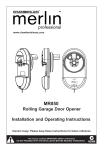Download Merlin MT600 Specifications
Transcript
Start by Reading These Important Safety Instructions Failure to comply with the following instructions may result in serious personal injury or property damage. • Read these instructions carefully • The garage door opener is designed and tested to offer reasonable safe service provided it is installed and operated in strict accordance with the instructions in this manual. These safety alert symbols mean Warning – a personal safety or property damage instruction. Read these instructions carefully. Keep garage door balanced. Do not let the garage door opener compensate for a binding or sticking garage door. Sticking or binding doors must be repaired. Garage doors, door springs, cables, pulleys, brackets and their hardware are under extreme tension and can cause serious personal injury. Do not attempt to loose, move or adjust them. Call for garage door service. Do not wear rings, watches or loose clothing while installing or servicing a garage door opener. To avoid serious personal injury from entanglement, remove all ropes connected to the garage door before installing the door opener. Installation and wiring must be in compliance with your local building and electrical codes. Connect the power supply cord only to properly earthed mains. Lightweight doors of fiberglass, aluminum or steel must be substantially reinforced to avoid door damage. (See page 6.) The best solution is to check with your garage door manufacturer for an opener installation reinforcement kit. The safety reverse system test is very important. Your garage door MUST reverse on contact with a 40mm obstacle placed on the floor. Failure to properly adjust the opener may result in serious personal injury from a closing garage door. Repeat the test once a month and make any needed adjustments. This unit should not be installed in a damp or wet space. Door must not extend over public byway during operation. CONTENTS PAGE SAFETY RULES . . . . . . . . . . . . . . . . . .1 DOOR TYPES . . . . . . . . . . . . . . . . . . . .2 TOOLS REQUIRED . . . . . . . . . . . . . . . .2 HARDWARE PROVIDED . . . . . . . . . . . .2 BEFORE YOU BEGIN . . . . . . . . . . . . . .3 COMPLETED INSTALLATION . . . . . . . .3 ASSEMBLY . . . . . . . . . . . . . . . . . . . . .3-4 INSTALLATION . . . . . . . . . . . . . . . . . .5-8 CONNECT ELECTRIC POWER . . . . . .6 PROGRAMMING THE CODE . . . . .9-10 ADJUSTMENT . . . . . . . . . . . . . . . .11-12 The Protector System must be installed when the force at the edge of the closing door force exceeds 400N (40kg). Excessive force will interfere with the proper operation of the Safety Reverse System or damage the garage door. Permanently fasten the caution label adjacent to the wall-mounted door control control button as a reminder of safe operating procedures. Disengage all existing garage door locks to avoid damage to garage door. Install the lighted door control button (or any additional push buttons) in a location where the garage door is visible, at a height of at least 1.5m and out of the reach of children. Do not allow children to operate push button(s) or remote control(s). Serious personal injury from a closing garage door may result from misuse of the opener. Activate opener only when the door is in full view, free of obstructions and opener is properly adjusted. No one should enter or leave the garage while the door is in motion. Do not allow children to play near the door. Use manual release only to disengage the trolley and, if possible, only when the door is closed. Do not use the red handle to pull the door open or closed. Disconnect electric power to the garage door opener before making repairs or removing covers. This product is provided with a power supply cord of special design which, if damaged, must be replaced by a power supply cord of the same type; such a power supply cord may be obtained and fitted by a specialist. CONTENTS PAGE INSTALL THE PROTECTOR SYSTEM (OPTIONAL) . . . . . . . . . . . . .12 SPECIAL FEATURES . . . . . . . . . . . . .13 ACCESSORIES . . . . . . . . . . . . . . . . . .13 REPLACEMENT PARTS . . . . . . . .14-15 CARE OF YOUR OPENER . . . . . . . . .15 MAINTENANCE OF YOUR OPENER .15 HAVING A PROBLEM? . . . . . . . . . 16-17 OPERATION OF YOUR OPENER . . . .17 SPECIFICATIONS . . . . . . . . . . . . . . . .17 WARRANTY . . . . . . . . . . . . . . . . . . . . .18 1 Warning: If your garage has no service entrance door, Model 1702E Outside Quick Release must be installed. This accessory allows manual operation of the garage door from outside in case of power failure. A. One-Piece Door with Horizontal Track Only B. One-Piece Door with Horizontal and Vertical Track – Special door arm (E, The Chamberlain Arm™) and The Protector System (29 (9)) are required. See your dealer. C. Sectional Door with Curved Track – See 20B – connect door arm. The Protector System (29 (9) is required for doors that are over 2.5m in height. D. Canopy door – Special door arm (E, The Chamberlain Arm™) and The Protector System (29 (9)) are required. See your dealer E. The Chamberlain Arm™ for use on door types B and D. A B D E C 2 TOOLS REQUIRED 1 2 10mm, 8mm, 4,5mm, 4mm 11mm, 13mm 11/13mm 3 HARDWARE PROVIDED (1) (2) (3) (4) (5) (6) (7) (8) (9) (10) (11) (12) (13) (14) (15) (16) (17) (18) (19) (20) Hex Bolt Clevis Pin 8mm Carriage Bolt Wood Screws Sheet Metal Screws Clevis Pin Rope Handle Insulated Staples Anchor Concrete Anchor Lock Washer Hex Nut Ring Fastener Hex Bolt Lock Nut Metric Tapping Screw Hex Screw Stop Bolt Remote Control Wall Mount Bracket (not all models) 6(2x) NOTIC E 1(2x) 4(4x) 2(2x) 5(2x) 15 (2x) 8 (1x) 7(1x) 9(10x) 13(5x) 11(4x) 10(2x) 19 (1x) 20 (1x) 14 (4x) 16 (2x) 3(2x) 12(5x) 17(2x) 18(3x) 2 1 DOOR TYPES 1. Look at the wall or ceiling above the garage door. The header bracket must be securely fastened to structural supports. 2. Do you have a finished ceiling in your garage? If so, a support bracket and additional fastening hardware (not supplied) may be required. 3. Depending on your door's construction, you might need a special door arm. See your dealer. 4. Do you have an access door in addition to the garage door? If not, Model 1702E Outside Quick Release Accessory is required. This accessory allows manual operation of the garage door from outside in case of power failure. 4 Completed Installation As you proceed with the assembly, installation and adjustment procedures in this manual, you may find it helpful to refer back to this illustration of a completed installation. (1) (2) (3) (4) (5) (6) (7) (8) (9) (10) Manual Release Rope & Handle (11) Curved Door Arm (12) Straight Door Arm (13) Door Bracket and Plate (14) Header Bracket (15) Trolley Release Arm Header Sleeve Idler Pulley Bracket Trolley Rail Chain/Belt Hanging Bracket Power Cord Opener Light Lens 7 1 2 14 13 4 3 5 6 11 12 9 9 8 15 10 ASSEMBLY SECTION IMPORTANT: If you have a canopy door, you need to use the instructions packed with The Chamberlain Arm™ Accessory in conjunction with this Owner's Manual when assembling the rail. 5 Assemble the Rail Grease inside edges of rail sections using grease (1). Place rail pieces (2) on flat surface for assembly. All four rail sections are interchangeable. Slide rail brace (3) onto rail section. Connect rail by sliding rail brace onto next rail section. Tap rail assembly (4) on piece of wood (5) until rail sections are flush. Repeat with remaining rail sections. 2 4 3 2 1 5 6 Install the Chain/Belt Remove chain/belt from carton and lay chain out on floor (do not allow chain/belt to twist). A. Chain: Push pins of master link bar (3) through chain link (4) and hole in back end of trolley (5). Push cap (2) over pins and onto notches. Slide clip-on spring (1) over cap and onto pin notches until both pins are securely locked in place. B. Belt: Hook the trolley connector (6) into the slot (7) on the trolley (8). 6 8 1 5 1 5 4 4 A-1” 7 2 2 B 3 3 A - 1/2” 3 BEFORE YOU BEGIN: 7 Insert Chain/Belt into Rail & 4 5 4 Assemble Header Sleeve 9 Slide pulley bracket (1) and inner trolley (2) into back (opener end) of rail assembly (3), be sure to insert pulley bracket as shown with arrow (4) pointing toward front (header end) of rail (5). Push bracket toward front (header end ) of rail (5). Insert carriage bolt (6) through header sleeve bracket (7). Loosely thread spring nut (8) and flat washer (9) onto carriage bolt. Insert carriage bolt (6) of header sleeve assembly (7) into bold cut out in pulley bracket (1). Slide header sleeve assembly (7) on to front (header end) of rail (10). 6 8 3 7 10 6 10 1 2 71 8 Attach Trolley to Rail 2 Slide outer trolley (1) into back (opener) end of the rail assembly (2), be sure end with trolley release arm (3) is heading in direction of opener. Slide outer trolley down rail until it engages with inner trolley. 1 3 9 Fasten Rail to Opener and Install Chain/Belt Holding chain (4) and belt (5) out of the way, slide rail (1) onto shim (2) until rail is secure. Take the chain/belt and wrap it around the sprocket (3). Make sure the teeth on the sprocket have engaged the chain/belt. 4 5 2 1 3 10 Attach Sprocket Cover Place sprocket cover (1) on top of the opener (2), secure with screws (3). 2 3 1 3 1 3 1 2 2 11 Assemble Header Sleeve Thread spring nut on carriage bolt until finger tight. Insert a screwdriver tip (1) into one of the slots of the nut ring (2) and brace it firmly against the header sleeve. Place an open end wrench (3) on the square end of the spring nut (4), slightly rotate nut about 1/4 turn clockwise until nut ring (2) is released against header sleeve (5). This sets spring to optimum chain tension. Chain may slip off sprocket if chain/belt is too loose. If chain does slip re-tighten spring nut by turing nut clockwise 1/2 turn. Do NOT overtighten chain/belt. 2 3 4 5 1 Wear protective goggles when working overhead to protect your eyes from injury. Disengage all existing garage door locks to avoid damage to the garage door. To avoid serious personal injury from entanglement, remove all ropes connected to the garage door before installing the opener. It is recommended that the opener be installed 2,1m (7 feet) or more above the floor where space permits. 12 Position the Header Bracket 1 The header bracket must be rigidly fastened to a structural support of the garage. Reinforce the wall or ceiling with a 40mm (1-1/2") board if necessary. Failure to comply may result in improper operation of safety reverse system. You can attach the header bracket either to the header wall (1) or to the ceiling (3). Follow the instructions which will work best for your particular requirements. With the door closed, mark the vertical centerline (2) of the garage door. Extend line onto header wall above the door. Open door to highest point of travel. Draw an intersecting horizontal line (4) on header wall 5 cm (2") above high point to provide travel clearance for top edge of door. 4 2 3 13 Install the Header Bracket NOTE: Refer to vertical center and horizontal lines created in step 12 for proper placement of header bracket. A. Wall Mount: Center the header bracket (1) on the vertical center line (2) with the bottom edge of the header bracket on the horizontal line (4) (with the arrow pointing toward the ceiling). Mark all of the header bracket holes (5). Drill 4,5mm (3/16") pilot holes and fasten the header bracket with wood screws (3). B. Ceiling Mount: Extend vertical center line (2) onto the ceiling. Center the header bracket (1) on the vertical mark no more than 150mm (6") from the wall. Make sure the arrow is pointing toward the opener. Mark all of the header bracket holes (5). Drill 4,5mm (3/16") pilot holes and fasten the header bracket with wood screws (3). For concrete ceiling mount, use concrete anchors provided. 5 2 50mm (2") 3 4 5 1 2 A 150mm (6") 3 B 14 Attach Rail to Header Bracket Position opener on garage floor below the header bracket. Use packing material to protect the cover. Raise rail until holes in the header sleeve and holes in the header bracket align. Join with clevis pin (1). Insert ring fastener (2) to secure. NOTE: To enable the rail to clear sectional door springs, it may be necessary to lift opener onto a temporary support. The opener must either be secured to a support or held firmly in place by another person. 1 2 2 1 1 5 INSTALLATION SECTION 1 6 15 Position the Opener NOTE: A 25mm (1") board (1) is convenient for setting an ideal door-to-rail distance (unless headroom is not sufficient). Raise the opener onto a stepladder. Open garage door. Place a 25mm (1") board (1) laid flat on the top section of door near the centerline as shown. Rest the rail on the board. If the raised door hits the trolley, pull down on the trolley release arm to disconnect the inner and outer trolley sections. The trolley can remain disconnected until connecting door arm to trolley is completed. 16 Hang the Opener The opener must be securely fastened to a structural support of the garage. Three representative installations are shown. Yours may be different. Hanging brackets (1) should be angled (Figure A) to provide rigid support. On finished ceilings, (Figure B) attach a sturdy metal bracket (not supplied) (4) to a structural support before installing the opener. For concrete ceiling mount, (Figure C), use concrete anchors provided. On each side of opener measure the distance from the opener to the structural support (or ceiling). Cut both pieces of the hanging bracket to required lengths. Flatten one end of each bracket and bend or twist to fit the fastening angles. Do not bend at the bracket holes. Drill 4,5mm (3/16") pilot holes in the structural supports (or ceiling). Attach brackets to supports with wood screws (2). Lift opener and fasten to hanging brackets with screw, lock washer and nut (3). Check to make sure rail is centered over the door. REMOVE 25mm (1") board. Operate door manually. If door hits the rail, raise header bracket. Use rail grease and lubricate bottom surface of rail (5). A 2 1 1 3 5 C 4 B 4 2 4 2 3 2 3 3 1 3 17 Attach Emergency Release Rope & Handle Thread one end of rope (1) through hole in top of red handle so "NOTICE" reads right side up as shown (3). Secure with an overhand knot (2). Knot should be at least 25mm (1") from end of the rope to prevent slipping. Thread other end of rope through hole in release arm of the outer trolley (4). Adjust rope length so that handle is 1,8m (6 feet) above the floor. Secure with an overhand knot. NOTE: If it is necessary to cut rope, heat seal cut end with a match or lighter to prevent fraying. 2 4 1 NOT ICE 3 2 Connect Electric Power TO AVOID INSTALLATION DIFFICULTIES, DO NOT RUN THE GARAGE DOOR OPENER UNTIL INSTRUCTED TO DO SO. Connect the door opener only to an outlet controlled by a double pole switch. 18 Install the Light and Lens Install a 40 watt maximum (230V, E27) light bulb in the socket (1). Hinge the bottom of the lens (2) onto the cover from left of the hinge bars (3) as shown. Close the lens by gently squeezing the upper corners and inserting the tabs (4) into slots on the cover (5). To change bulb, squeeze the upper corners of the lens to disengage tabs. The lens will drop open, remaining hinged at bottom. The light will turn on and remain lit for 2-1/2 minutes when power is connected. After 2-1/2 minutes it will turn off. 5 5 2 3 4 4 1 20 Assemble Door Arm A. ONE-PIECE DOOR INSTALLATION: Fasten the straight (1) and curved (2) door arm sections together to the longest possible length (with a 2 or 3 hole overlap) using carriage bolts (3), lock washers (4) and hex nuts (5). With the door closed connect the straight door arm section (1) to the door bracket with clevis pin (6). Secure with ring fastener (7). Disconnect the inner and outer trolley. Slide the outer trolley back toward the opener and join the curved arm (2) to the connector hole in the trolley (8) with clevis pin (6). It may be necessary to lift the door slightly to make the connection. Secure with ring fastener (7). NOTE: When setting the up limit, the door should not have a “backward” slant when fully open. A slight backward slant (9) will cause unnecessary bucking and/or jerking operation as the door is being opened or closed from the fully open position. B. SECTIONAL DOOR INSTALLATION: Connect according to Figure B, then proceed to Step 21. 7 19 Fasten Door Bracket If you have a canopy garage door, a door arm conversion kit is required. Follow the installation instructions included with the replacement door arm. Exercise care in removing and assembling arm conversion kit. Keep fingers away from the sliding parts. NOTE: Horizontal and vertical reinforcement is needed for lightweight garage doors. Sectional and One-Piece Door Installation Procedure: Door bracket (1) has left and right side fastening holes. If your installation requires top and bottom fastening holes use both the door bracket and door bracket plate (2) as shown. 1. Center door bracket (with or without door bracket plate, as required) at the top inside face of door as shown. Mark holes. A.Standard Sectional or One-piece doors: locate bracket at inside face of the door. B. Sectional doors with two horizontal roller channels: 150 - 250mm below the top of the door. 2. A. Wooden doors Drill 8mm holes (5/16") and fasten the door bracket with nut, lock washer, and carriage bolt (3). B. Sheet metal doors Fasten with wood screws (4). C. One-piece door optional Fasten with wood screws (4). A 3 1 2 B 1 2 1 2 1 4 2 A. 0-100mm B. 150-250mm C 4 1 A 7 4 5 1 6 2 3 8 9 B 7 5 4 1 3 2 6 6 3 21 Install Door Control 8 (optional accessory) Locate door control where the garage door is visible, away from door and door hardware and out of the reach of children. Mount at least 1,5 m (5 feet) above the floor. Serious personal injury from a moving garage door may result from misuse of opener. Do not allow children to operate the door control or remote control transmitter. Fasten the caution label permanently to the wall near the door control as a reminder of safe operating procedures. There are 2 screw terminals on the back of the door control . Strip about 6mm (1/4") of insulation from bell wire. Separate wires enough to connect the white/red wire to RED terminal screw 1 and the white wire to WHT terminal screw 2. Fasten the door control to an inside garage wall with sheet metal screws (3) provided. Drill 4mm (5/32") holes and use anchors if installing into drywall. A convenient place is beside the service door and out of reach of children. Run the bell wire up the wall and across the ceiling to the garage door opener. Use insulated staples to secure wire. The receiver quick connect terminals are located behind the light lens of the opener. Connect the bell wire to the terminals as follows: white/red to red and white to white (5). Operation of the Door Control Press to open or close the door. Press again to stop the door while moving. LOCK LIGHT Push Bar Cover 1 WHT 2 2 RED 1 3 1 5 1 O 2 3 – 60 s 180 s 120 s 6mm 4 Activate the opener only when door is in full view, free of obstruction and properly adjusted. No one should enter or leave garage while door is in motion. Do not allow children to operate push button(s) or remote(s). Do not allow children to play near the door. Your garage door opener receiver and remote control transmitter are set to a matching code. If you purchase additional remote controls, the garage door opener must be programmed to accept the new remote code. Program the Receiver to Match Additional Remote Control Codes: Using the orange “LEARN” Button: 1. Press and release the orange “learn” button on the opener. The learn indicator light will glow steadily for 30 seconds (1). 2. Within 30 seconds, press and hold the button on the handheld remote that you wish to operate your garage door (2). 3. Release the button when the opener light blinks. It has learned the code. If the light bulb is not installed, two clicks will be heard (3). Using the Motion Detecting Control Panel (optional accessory): 1. Press and hold the button on the hand-held remote that you wish to operate your garage door (4). 2. While holding the remote button, press and hold the LIGHT button on the Motion Detecting Control Panel (5). 3. Continue holding both buttons while you press the push bar on the Motion Detecting Control Panel (all three buttons are held) (6). 4. Release buttons when the opener light blinks. It has learned the code. If the light bulb is not installed, two clicks will be heard (7). Now the opener will operate when the remote control push button is pressed. If you release the remote control push button before the opener light flashes, the opener has not learned the code. To Erase all Remote Control Codes: To deactivate any unwanted remote, first erase all codes: Press and hold the orange “learn” button on opener until the learn indicator light goes out (approximately 6 seconds). All previous codes are now erased. Reprogram each remote or keyless entry you wish to use. 2 or 3-Channel Remote (optional accessory): If provided with your garage door opener, the large or center button is factory programmed to operate it. Additional buttons on any rolling code 2 or 3-channel remote or mini-remote can be programmed to operate this or other rolling code garage door openers. 9 22 Program your Opener & Remote 1 O – 60 s 180 s 120 s 1 3 2 LiftM aste r optional 4 6 5 7 LIGHT LOCK LOCK LIGHT LiftM aste r optional 2 3 1. Radio Wall Control (optional) 2. Remote Control Wall Mount (optional) 10 23 Program your Radio Wall Control 1 Activate the opener only when door is in full view, free of obstruction and properly adjusted. No one should enter or leave garage while door is in motion. Do not allow children to operate push button(s) or remote(s). Do not allow children to play near the door. Locate minimum 1.5m above the floor. Remote control slide-on wall mount bracket: -Attach to the wall with 2x ø 3.5 max.flat head screws (not provided ) -Slide remote control onto wall mount bracket NOTE: Tightening the wall mount screws will reduce clearance between bracket and wall. A 3-channel (3-button) remote control may be used for up to three Merlin garage door operators. 2 Program the Receiver to Match Additional Remote Control Code Using the orange “LEARN” Button: 1. Press and release the orange “learn” button on opener. The learn indicator light will glow steadily for 30 seconds. 2. Within 30 seconds, press and hold the button on theradio wall control that you wish to operate your garage door. 3. Release the button when the opener light blinks. It has learned the code. If the light bulb is not installed, two clicks will be heard. 24 Program your Keyless Entry (optional accessory) Activate the opener only when door is in full view, free of obstruction and properly adjusted. No one should enter or leave garage while door is in motion. Do not allow children to operate push button(s) or remote(s). Do not allow children to play near the door. NOTE: Your new Keyless Entry must be programmed to operate your garage door opener. Program the Receiver to Match Additional Remote Control Code Using the orange “LEARN” Button: 1. Press and release the orange “learn” button (1) on opener. The learn indicator light will glow steadily for 30 seconds. 2. Within 30 seconds, enter a four digit personal identification number (PIN) of your choice on the keypad (2), then press and hold the ENTER button. 3. Release the button when the opener light blinks (3). It has learned the code. If the light bulb is not installed, two clicks will be heard. Using the Motion Detecting Control Panel (optional accessory): NOTE: This method requires two people if the Keyless Entry is already mounted outside the garage. 4. Enter a four digit personal identification number (PIN) of your choice on the keypad, then press and hold ENTER. 5. While holding the ENTER button, press and hold the LIGHT button on the Multi-Function Door Control. 6. Continue holding the ENTER and LIGHT buttons while you press the push bar on the Multi-Function Door Control (all three buttons are held). 7. Release buttons when the opener light blinks. It has learned the code. If the light bulb is not installed, two clicks will be heard. 1 O – 60 s 180 s 120 s 1 2 3 6 7 LOCK LIGHT 4 5 LIGHT LOCK LOCK LIGHT 2 3 11 25 Using the Motion Detecting Control Panel (optional accessory) Press the push bar (1) to open or close the door. Press again to stop the door. Light feature Press the light button to turn the opener light on or off. It will not control the opener lights when the door is in motion. If you turn it on and then activate the opener, the light will remain on for 2 1/2 minutes. Press again to turn it off sooner. The 2 1/2 minute interval can be changed to 1-1/2, 3-1/2 or 4-1/2 minutes as follows: Press and hold the Lock button until the light blinks(about 10 seconds). A single blink indicates that the timer is reset to 1-1/2 minutes. Repeat the procedure and the light will blink twice, resetting the timer to 2-1/2 minutes. Repeat again for 3-1/2 minute interval, etc., up to a maximum of four blinks and 4-1/2 minutes. Lock feature Designed to prevent operation of the door from hand-held remote controls. However, the door will open and close from the Door Control, the Outside Keylock and the Keyless Entry Accessories. To activate, press and hold the Lock button (3) for 2 seconds. The push bar light will flash as long as the Lock feature is on. To turn off, press and hold the Lock button again for 2 seconds. The push bar light will stop flashing. The Lock feature will also turn off whenever the “LEARN” button on the opener panel is activated. LOCK LIGH T ADJUSTMENT SECTION 26 Setting the Limits Travel limits regulate the points at which the door will stop when moving up or down. Follow the steps below to set the limits. You may program the limits automatically or manually. 1 Setting the limits automatically: O 2 3 – 60 s 180 s 120 s 3 1. Press and hold the black button (1) until the yellow indicator light (3) starts flashing slowly and then release. 4 2. Push and hold the black button (1) until the door reaches the desired 1 2 open position. Adjust the position of the door by using the black (1) and orange (2) buttons. Black moves the door UP, orange moves the door 1 2 3 DOWN. 3. Push the programmed remote control (4) or push bar on the door control that was shipped with your opener. This sets the full UP (open) position. The door will travel to the floor and reverse back to the UP optional (open) position. The opener has learned its travel limits. Check to be sure the door is high enough for your vehicle. Adjust if necessary. 4. The indicator light (3) will stop flashing when the limits have been learned. If the door stops or reverses before it reaches the floor repeat steps 1-3 immediately. If this does not set the limits, proceed with setting the limits manually. The force MUST be learned in order to properly complete the setting of the limits. LiftM aste r Setting the limits manually: 1. Press and hold the black button until the yellow indicator light starts flashing slowly then release. 2. Adjust the position of the door by using the black and orange buttons. Black moves the door UP (open) and orange moves the door DOWN (close). Check to be sure the door opens high enough for your vehicle. 3. Push the remote control or door control. This sets the UP (open) limit and begins closing the door. Immediately press either the orange or the black button. The door will stop. Adjust the desired DOWN (close) limit position using the black and orange buttons. Check to be sure the door is fully closed without applying excessive pressure on the rail (rail should not bow upwards and the chain/belt should not sag or droop below the rail). Push the remote control or door control. This sets the DOWN (close) limit and begins opening the door. NOTE: If neither the black or the orange button is pressed, the door will reverse off the floor and the DOWN travel limit will beset automatically. 4. Open and close the door with the remote control or door control 2 or 3 times. • If the door does not stop in the desired UP (open) position or reverses before the door stops at the DOWN (close) position, set the Force, see adjustment steps 26 and 27. • If the door stops in both the desired UP (open) and DOWN (close) positions, proceed to Test the Safety Reversal System. 12 27 Setting the Force The force, as measured on the closing edge of the door, should not exceed 400N (40kg). If the closing force is measured to more than 400N, the Protector System must be installed See step 29. The force setting regulates the amount of power required to open and close the door. 1. Locate the orange button (2). 2. Push the orange button (2) twice to enter unit into Force Adjustment Mode. The LED (3) (indicator light) will flash quickly. 3. Push the programmed remote control (4) or push bar on the door control that was shipped with your opener. The door will travel to the DOWN (close) position. Push the remote control (4) again, the door will travel to the UP (open) position. The LED (3) (indicator light) will stop flashing when the force has been learned. The door must travel through a complete cycle, UP and DOWN, in order for the force to be set properly. If the unit cannot open and close your door fully, inspect your door to insure that it is balanced properly and is not sticking or binding. 1 O 60 s 120 s 4 2 2(2x) 3 LiftM aste r optional 28 Test the Safety Reverse System 29 Install the Protector System™ (See accessories) Install this accessory for all installations on Canopy doors, One-Piece Door with Horizontal and Vertical Track , doors over 2.5m and when the closing force as measured on the bottom of the door is over 400N (40kg). After opener has been installed and adjusted, The Protector System™ accessory can be installed. Instructions are included with this accessory. The Protector System™ provides an additional measure of safety against a small child being caught under a garage door. It uses an invisible beam which, when broken by an obstruction, causes a closing door to open and prevents an open door from closing and is strongly recommended for homeowners with young children. Note: The opener will automatically detect the protector system when it is installed. The opener will not close unless the sensors are aligned. 3 – 180 s LiftM aste r The safety reverse system test is important. Garage door must reverse on contact with a 40mm obstacle laid flat on the floor. Failure to properly adjust opener may result in serious personal injury from a closing garage door. Repeat test once a month and adjust as needed. Procedure: Place a 40mm obstacle (1) laid flat on the floor under the garage door. Operate the door in the down direction. The door must reverse on the obstruction. If the door stops on the obstruction, remove obstruction and repeat Setting the Limits step 26. Repeat test. When the door reverses on the 40mm obstacle, remove the obstruction and run the opener through a complete travel cycle. Door must not reverse in closed position. If it does, repeat Setting the Limits and Force steps 26 and 27 and repeat safety reverse test. Place 20kg at the center of the door and ensure that the door will not move up more than 500mm. 2 LiftM aste r 1 3 1. 2. Flashing light connection The flashing light can be installed anywhere. Connect light leads to quick connect terminals 1 and 2. Terminal 2 is ground. Timer to close function can be enabled by turning the dial to the required time. If the protector system is installed the timer to close should be set after the protector system is installed. LIGHT (1)Model CM842 (2)Model CM128 (3)Model C940 (4)Model C943 (5)Model C945 (6)Model 75LM (7)Model C98 (8)Model C840 (9)Model C77 (10)Model 1702E (11)Model 760E (12)Model MDL100LM (13)Model EQL01 (14)Model 9-13-1 CM842 Double-Function Remote Control Remote Wall Button Single-Function Remote Control 3-Function Remote Control 3-Function Mini Remote Control Illuminated Door Bell Push Button Motion Detecting Control Panel Keyless Entry System The Protector System Quick Release Lock Outside Keylock Mechanical Door Latch Kit Door Handle Quick Release Door Reinforcement Bracket C940 CM128 1 2 10 9 60s 120s C98 75LM C77 FLA230 ACCESSORIES NOT ILLUSTRATED Model CM475 Evercharge Battery Sytem Model 89LM Vibration Isolator Kit Model SDA-1LM Wing Door Adaptor Model CSTAR Star 250-433 Access Control Model 041A2743X Star Watertight Box Model 86LM Star Antenna Extension Kit Model 23024E Star Transformer 230V/24V WIRING INSTRUCTIONS FOR ACCESSORIES Outside Keylock – To opener terminals: Red-1 and White-2 Protector System™ – To opener terminals: White-3 and Grey-4 Door Control Panel – To opener terminals: Red-1 and White-2 C840 C98 75LM C945 6 3 1702E C77 C943 3 o 180s LOCK 31 Accessories 2 1 13 30 Special Features 4 LOCK 5 MDL100LM 760E 7 LIGHT EQL01 8 9-13-1 11 12 13 14 14 32 REPLACEMENT PARTS C VD 12 Pb Cd Hg 144C77 171A28 41A5801-1 (1.7m) 41A5801 (2.3m) 41A5801-2 (2.5m) 41A5801-3 (3.0m) 12C810 83A11 41B4101-1 31D525 41A5800 12B374 41B4494-1 7423CR3 210C42 7017CR3 7023CR3 7030CR3 7035CR3 183D177 183D178 178B34 8423CR3 8430CR3 41B4103 12C855 8023CR3 8025CR3 8030CR3 12C778 41A5414-4 41A2828 NOT ICE 4A1008 1/2” 109A46 1” 41A5844 (2.3m) 41A5844-1 (2.5m) 41A5844-2 (3.0m) 12B380 31D537 33 REPLACEMENT PARTS 15 171A543 Belt 41A4371-3 Chain 41A4371-2 28A95 158A49 171A498 26B72 216A206 41C589 171A479 41B5348 37D117-2 41B4375-3 41C5392 171A315 41B5351-5 171A384-8 41C5350-5 (60kg) 41C5350-2 (100kg) 41A5696-2c (60kg) 41A5696-4c (100kg) 171A384 41D701-2 (60kg) 41D605 (100kg) 171A545 108D56 41D188 171A320 CARE OF YOUR OPENER When properly installed, opener will provide high performance with a minimum of maintenance. The opener does not require additional lubrication. Limit and Force Settings: These settings must be checked and properly set when opener is installed. Weather conditions may cause some minor changes in the door operation, requiring some re-adjustments, particularly during the first year of operation. Refer to Setting the Limits and Force on page 10. Follow the instructions carefully and repeat the safety reverse test after any adjustment. Remote Control: The remote control may be secured to a car sun visor with the clip provided. Additional remotes can be purchased at any time for use in all vehicles using garage. Refer to Accessories. Any new remotes must be programmed into the opener. Remote Control Battery: The lithium batteries should produce power for up to 5 years. If transmission range lessens, replace battery . To Change Battery: To replace batteries, use the visor clip or screwdriver blade to pry open the case. Insert batteries positive side up. To replace cover, snap shut along both sides. Do not dispose of the old battery with household waste. Take batteries to a proper disposal center. MAINTENANCE OF YOUR OPENER Once a Month: • Repeat safety reverse test. Make any necessary adjustments. • Manually operate door. If it is unbalanced or binding, call for professional garage door service. • Check to be sure door opens and closes fully. Set Limits and/or Force if necessary. Once a Year: • Oil door rollers, bearings and hinges. The opener does not require additional lubrication. Do not grease the door tracks. • GREASE THE RAIL AND THE TROLLEY. 1. Opener doesn't operate from either door control or remote: • Does the opener have electric power? Plug lamp into outlet. If it doesn't light, check the fuse box or the circuit breaker. (Some outlets are controlled by a wall switch.) • Have you disengaged all door locks? Review installation instruction warnings on page 1. • Is there a build-up of ice or snow under door? The door may be frozen to ground. Remove any obstruction. • The garage door spring may be broken. Have it replaced. 2. Opener operates from remote but not from door control: • Is door control button lit? If not, remove the bell wire from the opener terminals. Short the red and white terminals by touching both terminals at the same time with a piece of wire. If the opener runs, check for a faulty wire connection at the door control, a short under the staples, or a broken wire. • Are wiring connections correct? Review page 7. 3. Door operates from door control but not from remote: • Replace battery if necessary. • If you have two or more remotes and only one operates, review Program Your Opener, Remote and Keyless Entry steps 22 and 24. • Is the door control button flashing? The opener is in lock mode. If you have a Motion Detecting Control Panel, push and hold the Lock button for 2 seconds. The door control button will stop flashing. 4. Remote has short range: • Is battery installed? • Change the location of the remote control on the car. • A metal garage door, foil-backed insulation or metal siding will reduce the transmission range. 5. Door reverses for no apparent reason and opener light doesn't blink: • Is something obstructing the door? Pull manual release handle. Operate door manually. If it is unbalanced or binding, call for professional garage door service. • Clear any ice or snow from garage floor area where garage door closes. • Repeat Setting Limits and Force, see adjustment steps 26 and 27. Repeat safety reverse test after adjustment is complete. 6. Door reverses for no apparent reason and opener light blinks for 5 seconds after reversing: Check The Protector System™ (if you have installed this accessory). If the light is blinking, correct alignment. 7. Opener noise is disturbing in living quarters of home: If operational noise is a problem because of proximity of the opener to the living quarters, Vibration Isolator Kit 89LM can be installed. This kit was designed to reduce the "sounding board effect" and is easy to install. 8. The garage door opens and closes by itself: Make sure remote push button is not stuck "on". 9. Door stops but doesn't close completely: Repeat Setting the Limits, see adjustment step 26. Repeat safety reverse test after any adjustment of door arm length, close force or down limit. 10. Door opens but won't close: • Check The Protector System™ (if you have installed this accessory). If the light is blinking, correct alignment. • If opener light does not blink and it is a new installation, repeat Setting the Limit and Force steps 26 and 27. Repeat the safety reverse test after the adjustment is complete. 11. Opener light does not turn on: Replace light bulb (230V/40W maximum). Replace burned out bulbs with rough service light bulbs. 12. Opener strains: Door may be unbalanced or springs are broken. Close door and use manual release rope and handle to disconnect trolley. Open and close door manually. A properly balanced door will stay in any point of travel while being supported entirely by its springs. If it does not, call for professional garage door service to correct the problem. 13. Opener motor hums briefly, then won't work: • Garage door springs are broken. SEE ABOVE. • If problem occurs on first operation of opener, door is locked. Disable door lock. Repeat safety reverse test after adjustment is complete. 14. Opener won't activate due to power failure: • Pull manual release rope and handle down to disconnect trolley. Door can be opened and closed manually. When the power is restored, pull the manual release handle down and toward opener. The next time the opener is activated, the trolley will reconnect. • The Outside Quick Release accessory (if fitted) disconnects the trolley from outside the garage in case of power failure. 16 HAVING A PROBLEM? OPERATION OF YOUR OPENER Your opener can be activated by any of the following devices: • The Lighted Door Control Button. Hold the button down until door starts to move. • The Outside Keylock or Keyless Entry System (if you have installed either of these accessories). • The Remote Control Transmitter. Hold the push button down until the door starts to move. Opening the Door Manually: Door should be fully closed if possible. Weak or broken springs could allow an open door to fall rapidly. Property damage or serious personal injury could result. The door can be opened manually by pulling the release handle down. To reconnect the door, pull the release handle down and toward the opener. Do not use the manual release handle to pull the door opener or closed. When the Opener is Activated by Remote Control or Lighted Door Control Button: 1. If open, the door will close. If closed, the door will open. 2. If closing, the door will stop. 3. If opening, the door will stop (allowing space for entry and exit of pets and for fresh air). 4. If the door has been stopped in a partially open or closed position, it will reverse direction. 5. If an obstruction is encountered while closing, the door will reverse. 6. If an obstruction is encountered while opening, the door will reverse and stop. 7. The optional Protector System™ uses an invisible beam which, when broken by an obstruction, causes a closing door to open and prevents an open door from closing. It is STRONGLY RECOMMENDED for homeowners with young children. Allow a 15 minute cooling period after 5 continuous operations of the opener. The opener light will turn on: 1. when opener is initially plugged in; 2. when the power is briefly interrupted; 3. when the opener is activated. The light turns off automatically after 2-1/2 minutes. Bulb size is 230V/40W maximum. Input Voltage ....... Max. Pull Force ... Power .................. Watts.................... Standby Power .... Motor Type..................... 230-240 VAC, 50Hz 600N (MT600), 1000N (MT1000) 6Nm (MT600), 10Nm (MT1000) 130M (MT600), 190W (MT1000) 5.5W (MT600), 6.5W (MT1000) DC gearmotor permanent lubrication Drive Mechanism Drive .................... Chain/belt with two-piece trolley on steel rail. Length of Travel... Adjustable to 2,3m (7-1/2 feet) Travel Rate .......... 5"-7" (127-178mm) per second Lamp.................... On when door starts, off 2-1/2 minutes after stop. Door Linkage ....... Adjustable door arm. Pull cord trolley release. Safety Personal .............. Push button and automatic stop in down direction. Push button and automatic stop in up direction. Electronic............. Automatic force adjustment Electrical .............. Transformer overload protector and low voltage push button wiring. Limit Device......... Optical RPM/Passpoint detector. Limit Adjustment .. Electronic, Semi and Fully Automatic. Start Circuit .......... Low voltage push button circuit. Dimensions Length (Overall)... 3,2m (122-1/2") Headroom Required 30mm Hanging Weight ... 14,5 kg (32 lb) Receiver Memory Registers 16 (MT600), 64 (MT1000) Operating Frequency 433.92MHz SPECIAL NOTE: Merlin strongly recommends that the protector system be installed on all garage door openers. 17 15. Setting the limits manually: 1. Press and hold the black button until the yellow indicator light starts flashing slowly then release. 2. Adjust the position of the door by using the black and orange buttons. Black moves the door UP (open) and orange moves the door DOWN (close). Check to be sure the door opens high enough for your vehicle. 3. Push the remote control or door control. This sets the UP (open) limit and begins closing the door. Immediately press either the orange or the black button. The door will stop. Adjust the desired DOWN (close) limit position using the black and orange buttons. Check to be sure the door is fully closed without applying excessive pressure on the rail (rail should not bow upwards and the chain/belt should not sag or droop below the rail). Push the remote control or door control. This sets the DOWN (close) limit and begins opening the door. NOTE: If neither the black or the orange button is pressed, the door will reverse off the floor and the DOWN travel limit will be set automatically. 4. Open and close the door with the remote control or door control 2 or 3 times. • If the door does not stop in the desired UP (open) position or reverses before the door stops at the DOWN (close) position, repeat Setting the Limits and Force, see adjustment steps 26 and 27. • If the door stops in both the desired UP (open) and DOWN (close) positions, proceed to Test the Safety Reversal System. Garage Door Opener Limited Warranty Merlin Garage Openers Limited warrants to the original purchaser (“the Buyer”) that the Merlin garage door opener (“the Unit”) sold under this warranty will be free from defects in materials and workmanship for a period of: MT1000, 60 full months (5years); MT600, 12 full months (1year) from date of purchase. Accordingly if the Unit fails due to defects in materials or workmanship within the warranty period Merlin Garage Openers Limited will, provided the defective part or Unit is returned freight and insurance prepaid and well packaged to the nearest address listed in this manual, undertake to repair or, at its option replace, any defective part or Unit and return it to the Buyer at no cost. Repairs and replacement parts are warranted for the remaining portion of the original warranty period. Limited warranty on motor. Through 60 months (MT1000) and through 24 months (MT600), Merlin will furnish a replacement motor, if it is found to be defective; free of charge. Labour costs will be charged. Where the Unit has been installed by an authorised installer, Merlin Garage Openers Limited will furnish replacement parts free of charge through the authorised installer. A service fee on site service may apply. LIMITATIONS It expressly excludes any batteries or light bulbs and malfunctions or defects to the Unit or its operation due to any of the following: A Failure to observe installation, adjustment, maintenance or operating instructions provided with the Unit; B Incorrect installation, operation or adjustment of the garage door to which the Unit is fitted; C Connection to any garage door outside the specifications set out in the owners manual; D Any modification or repair to the Unit carried by a person not authorised to do so by Merlin Garage Openers Limited; E Radio or any other electrical or electronic interference; F Faulty or unsuitable electrical wiring of the building to which the Unit is attached; G Faulty or flat batteries in the remote control transmitter; H Where the defect is due to: conditions other than normal domestic use or dirt, misuse, neglect, fire, accident, electrical storm or other act of God. This warranty is void if the serial number has been altered, defaced or moved. The liability of the Distributor for any loss or damage or injury arising directly or indirectly from any defect in the goods supplied is limited to the replacement or repair of such goods or to damages not exceeding the invoice value of such goods at the option of Merlin Garage Openers Limited. FUTURE MODIFICATIONS Merlin Garage Openers Limited may modify any existing or future model of the Unit without the obligation to incorporate these modifications into Units already manufactured or into the Unit to which this warranty applies. GENERAL This warranty is the only Warranty made by Merlin Garage Openers Limited. All other warranties, representations and conditions of any kind, express or implied, are hereby excluded. Nothing in this warranty is intended to have the effect of contracting out of the provisions of the Consumer Guarantees Act (1993) except to the extent provided by that Act and all provisions of this warranty shall be read and modified to the extent necessary to give effect to that intention. This warranty does not deprive the Buyer of any rights conferred upon them by any applicable law or statute in their country of purchase. Proof of date of purchase may be required when making a claim under warranty. In the event that the Buyer is unable to provide adequate proof of purchase the date of warranty will apply from date of shipment from the Distributor to the Reseller. NOTE We request that you attach your sales docket or invoice to this manual to enable you to establish the date of purchase in the unlikely event of a service call being made. Merlin Garage Openers Limited do not accept responsibility for damage or injury resulting from installing this opener. Merlin Garage Openers Limited reserve the right to change the design and specification without prior notification. Some features or accessories may not be available in certain markets or areas. Please check with your distributor. In-warranty service During the warranty period, if the product appears as though it may be defective, call our toll free service before removal of the unit. A Merlin technician will diagnose the problem and promptly supply you with the parts for “do-it-yourself” repairs, or provide you with shipping instructions for a factory repair or replacement. If an Authorised Installer installed your unit you must call them for prompt on-site service. After warranty Need help after the warranty period? Need help obtaining parts, service and accessories? See your yellow pages or phone Merlin toll free. Merlin service centres: New Zealand Auckland phone 09 415 4393 Phone toll free 0800 653 667 or 0800 MERLIN Fax toll free 0800 653 663 Australia NSW, Vic, Qld, WA Phone toll free 1800 638 234 Fax toll free 1800 888 121 www.merlingo.com 18 Warranty - please return your warranty card NOTES: 114A3354 ©, 2006





















